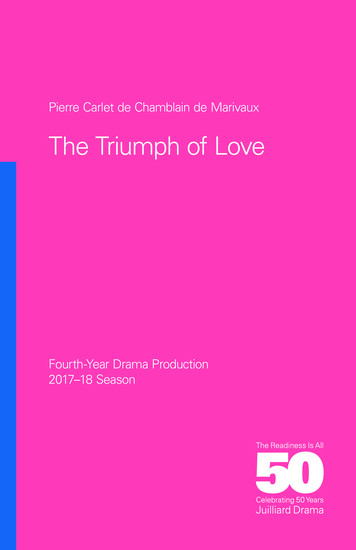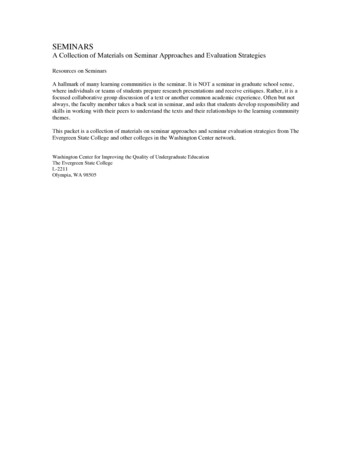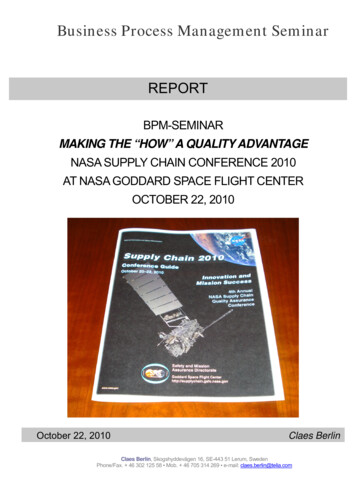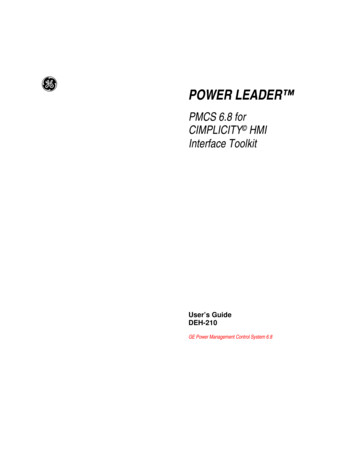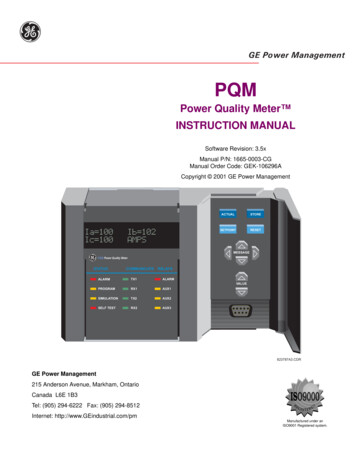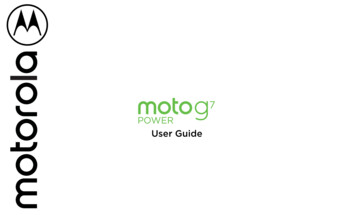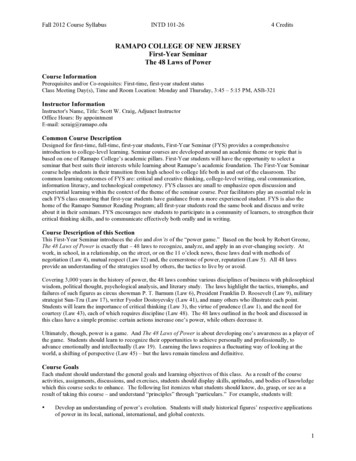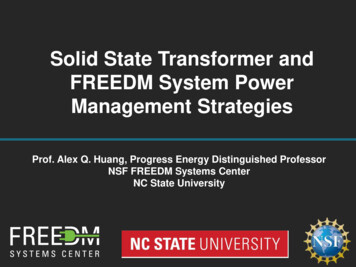
Transcription
Solid State Transformer andFREEDM System PowerManagement StrategiesProf. Alex Q. Huang, Progress Energy Distinguished ProfessorNSF FREEDM Systems CenterNC State University1
Presentation Outline1. FREEDM System: A Resilient and Smart DistributionSystem2. Solid State Transformer Three Generations of FREEDM Developed SSTTechnology3. Advanced Power Management Functions of the SST4. FREEDM System Intelligent Power Management (IPM)Control5. Towards Energy Internet
Low Voltage Power Delivery System at the Edge of ICT:Power Electronics Impact in the last 50 Years Plug-and-play of efficient powerUnprecedented power qualityIsolation of load dynamics by POL(Point of Load) convertersNecessary for DC loadsPOLs400V (DC)60-264V )SystemPower(DC)MemoryPower(DC)GraphicsPower(DC)BV 30VSi MOSFETGaN HFET Front end AC/DC 12V (DC)Silicon power device’smost important contribution(BV 600VSi BJT, Si MOSFET to GaN HFET)BJT: 19471970: SMPS On board DC/DC 1980: power MOSFET2010: GaN HFET3
High Voltage and Medium Voltage PowerDelivery System: Grid Edge Control ChallengeTransformer History:invented in 1886 byWilliam StanleySplitphase120/240VElectricity grid in North America. Source: [1]Distribution grid transformer (pole mounted)William Stanley Designed for unidirectional power flow and century-oldtransformer technology with little controllability beyond substation Requires a wide spectrum of products for power quality improvement (SVC,active filter, voltage compensator, DVR, etc.) Strong coupling and won’t isolate harmonics/other disturbances Not friendly for integration of renewable energy source (DC-typed sourcesneed more conversion stages, synchronization), EV, electronic load[1] Electricity grid simple- North America" by United States Department of Energy, SVG version by User:J Jmesserly reliability/blackout/ch1-3.pdf Page 13 Title:"Final Report on the August 14, 2003 Blackout in the United Statesand Canada" Dated April 2004. Accessed on 2010-12-25. Licensed under Public domain via Wikimedia tricity grid simple- North America.svg#mediaviewer/File:Electricity grid simple- North America.svg4
Direct medium voltage power conversionAddressing climate change grand challenge: higher penetration of distributedgeneration/storage/renewable hence the need for better control (µs hour)Direct medium voltage power conversion [1] power conversion without 60 Hz transformer Smart functions for enhanced grid edge controlMV DC4160-69 kV leEnergyGenerationEnergyStorage Front end AC/DC LV DC(400V)Solid State TransformerOthersLV ACInverter[1] Huang, NSF ERC proposal, 20075
FREEDM System Physical ArchitectureA resilient grid and an ubiquitous IT node are needed for future gridFault Isolation DeviceBi-directional flowDGISoftwareSolid State Transformer380 VDC Bus120V/240V ACDGStorageStoragePlug-and-play DC or AC Microgrid (Energy Cell)DG6
SST for A Complete DC GridsoftwaresoftwareStorageDGPlug-and-play DC MicrogridIn this case SST is absolutely needed since there is no 60Hz DC Transformer7
Medium Voltage (MV) SST TechnicalApproach & Research AreasVision:(plug-and-play and resilient grid for high DER penetration)LV ACOutputMV ACInputFuse 5"Lo60HzTransformerControlsGen- 1 SST: Sibased (6.5 kV IGBT3kHz)Topology/magneticsLV MOSMV MOSTransformerCrpMOV10"17"Crs24"Gen- 2 SST: SiCbased (15 kV SiCMOSFET 10 kHz)Gen- 3 SST:SiC @ 40 kHzWide Bandgap DevicesSiC & GaN power devices,other wide bandgapWBG power devicepackaging8
SST Grand Challenge: High Input Voltage? 1968: Si bipolar transistor breakdown voltage is only 100V Also the topology is not directly usable due to voltage overshoot etc9
Three Stage Medium Voltage SSTMVDC LinkcapacitorDistribution gridVgAC/DCMedium voltageIsolatedZVS DC/DCConverterLVDC LinkcapacitorDC/ACLV ac feederLow voltageMedium Frequency Transformerfor galvanic isolation10
SST Grand Challenge: High Input VoltageGen-I SST 6.5kV Si IGBT basedInput: 7.2kVac Output: 240Vac/120Vac; 400Vdc Power rating: 20kVAThree stage power conversionDC/DC ConverterAC/DC RectifierSH1SH2SH5SH6S1S2S3S4High FrequencyTransformerL3.8kVDCSH3DC/AC Inverter 400VDC-SH7SH4SH8LsPort 1CsLsCs -Port 2High VoltageH-BridgeHigh voltageH-Bridge120V /240V ACLow VoltageH-BridgePort 37.2 kV AC3.8kVDC -400VDC - 400V DC6.5-kV / 25-ASi IGBT-IncreasingVoltage3.8kVDC --Wang et. al, “Design and hardware implementation of Gen-1 silicon based solid statetransformer," APEC 201111
WBG Material AdvantagesSiLow on-state lossesSiCElectric Field(MV/cm)4GaNHigh voltage capability3Electron Mobility(10 3cm 2/s)21Energy Band Gap(eV)0ElectronSaturationVelocity(10 eration12
SiC Capability10X increaseSource: Vipin Pala et. al, ECCE2014100X reductionSJ10X reductionGaNTheoretically about 1000X reduction over Si MOSCurrently about 100X reduction achieved for 600V rangeThe improvement is only about 10X over SJ devices!13
15kV SiC GTO, n-IGBT and MOSFET25 SiC bipolar devices are more suitable for high temperature operation
15 kV SiC MOSFET Switching Losses Much lower switching loss comparedwith 6.5 kV IGBT; Up to 8 kHz even in hard switchingcondition. Turn-on loss can be eliminated in ZVSoperation15
15 kV SiC MOSFET Output ChargeMeasurement and ModelingHigh VoltageZiOutput charge model :Q1Rd VdcVinCdcDUTRsVQoss (Vds ) 11.43 Vds 0.0406 (nC)Q2VsOutput Charge of 15kV SiC MOSFET &JBS1200AIdciQHalf-Bridge Output ChargeMeasurement System High voltage (up to kV) High accuracy ( 1% error) No special equipment neededQoss / nC Simple configuration1000800600fs 0.625kfs 1.25k4002000020004000Vdc / V6000800016
With SiC MOSFET: 15 to 300 XimprovementsBreakdownVoltage (kV)Figure of Merit BV*fsw16SiC MOSFETHard Switching12SiC MOSFETSoftSwitching8Siliconbipolar490 Mhz-V1.5 GHz-V5 MHz-V (thermally limited)0.1110100Maximum switching frequency (kHz)
Three Stage SST with DAB Isolated DCDC ConverterGen-II SST Specifications: Input: 7.2kVac Output: 240Vac/120Vac; 400Vdc Power rating: 20kVATested Condition: Input: 3.6kVac Output: 240Vac; 400Vdc Power rating: 10kVAThree stage power conversion12 kVdc18
Measured Efficiency of Three Stage SSTwith DAB Isolated DC-DC ConverterAC-DC Rectifier 5%95.0%6 kHz12 3040Power(kW)99.4%DAB DC-DC 5Power(kW)DC-AC Inverter EfficiencyEfficiency99.2%99.0%1.2V SiC MOSFET98.8%98.6%600V Si IGBT98.4%98.2%1.2kV Si IGBT98.0%05Load(kW) 101519
Improved Three Stage SST with SRCIsolated DC-DC ConverterTested Condition:Gen-II SST Specifications: Input: 3.6kVac Output: 240Vac; 400Vdc Power rating: 10kVA Input: 7.2kVac Output: 240Vac/120Vac; 400Vdc Power rating: 20kVAThree stage power conversionLgR1R3Cmv1P1vMVLsirS1im L mR2R4AC-DC RectifierCmv2P2Series Resonant DC-DC ConverterMedium Voltage15KV/10A SiC MOSFETR7R5Crs1vLVClvn:1S2Crs2R6R8DC-AC InverterLow Voltage1.2KV/100A SiC MOSFET20
Medium Voltage Isolated DAB vs SRCDC-DC Stage Efficiency98.4%40 kHz Series Resonant 0 kHz 2 Soft Switching Over Full Load range Improved medium frequency transformer design1421
Single Stage Medium Voltage SSTDistribution gridIsolatedZVS AC/ACConverterVgMedium voltageLV ac feederLow voltageMedium Frequency Transformerfor galvanic isolation22
Single Stage Medium Voltage SSTGen-III SST Specifications: Input: 7.2kVac Output: 280Vac Power rating: 20kVATested Conditions: Input: 3.6kVac Output: 280Vac Power rating: 10kVASingle stage power conversionvovinLgLoR1R3Crp1P1vinvMVR2R4LsirS1im LmCrp2Unfolding BridgeMedium Voltage15KV/10A SiC MOSFETP2R5Crs1Con:1S2R7vLVvoR6Crs2Series Resonant ConverterR8Unfolding BridgeLow Voltage1.2KV/100A SiC MOSFET23
Gen-III SST Major Achievement:Vin 4.2 kV AC, Po 8kWQ1 Lsn:1irCrp2-LoQ3Crp1LmCoVoCrs2 Vds2-Q2 Crs1Q4LV ACOutput-MV ACInputFuse sLV MOSMV MOSTransformerCrpMOV10"Vin24"Gen-III SST Prototype(24inch*30inch*10inch)4.2kV AC – 280V AC Experimental Waveforms @ 8kW24
Three Generations of SSTsTransformation of the distribution power grid with smart Solid State TransformersLV ACOutputMV ACInputFuse 0HzTransformer Gen- 1 SST:6.5 kV IGBT@ 3 kHzCrsLV MOSMV MOSTransformerCrpMOV10"17"25"Lo24"Gen- 2 SST:15 kV SiC@ 6 kHz & 40 kHzGen- 3 SST:15 kV SiC@37 kHzGen-1 and Gen-2 features three stage solutions, and have all the desired smart functionsGen-3 is a single stage solution, the focus is on cost and efficiency25
Three Generations of SST MeasuredEfficiency (MV AC- LV AC)Efficiency vs LoadGen III98Gen II with SRC96Efficiency / %Vin 3.6 kVac,rms94Gen II with DAB9290Gen-I: 90%8886840 200040006000Load / W800010000Much higher efficiency through single stage, improved magnetics and soft switching2% improvement compared to Gen-II SST, 7% over Gen-IReached 97% for the MV AC-AC SST26
Three Generations of SST PowerDensity Vs Efficiency98.0%Power Density Vs Efficiency96.0%94.0%36"MV ACInputFuse gBridgeLi30"88.0%Lo86.0%CrsLV MOS84.0%MV MOSTransformerCrpMOV10"EfficiencyLV ACOutput24"82.0%80.0%0.250.450.650.85Powerdensity (W/in3)1.051.2527
SST Winning Strategy for Smart GridMicrosecondSoftwareSSTLVAC 120/240VOr 3phase 480VCommunication(IEC61850, DNP3,Modbus)LV DC 380VcontrolUtility Distribution Feeder Fault management Current limiting Disconnect/reconnect Power Management:1. Control power factor/Var Injection2. Change/Control customer voltage3. Low voltage ride through4. Eliminate customer side harmonics5. Provide DC power/Forming DCMicrogrid6. Bidirectional Power flow control viaEnergy Cell aggregation7. Supports advanced powermanagements and islanding modes Energy Management Monitor energy usage (AMI) Can control/dispatch power viamicrogrids (Energy Cell)28Hours Demand side management
Three Stage Medium Voltage SST: Supports ManyPower Management Smart Features7. Disconnect from grid to formislanding operationsMVDC LinkcapacitorDistribution gridVgLVDC LinkcapacitorIsolatedZVS DC/DCConverterAC/DCMedium voltage1. Independent Q junctionLV ac feederDC/ACLow voltage4. Absorb any AC sideharmonic currents3. Temporary energyFor LVRT2: Load regulation5. Forming DC Microgrid6. Power flow control29
1.Reactive power compensation: 3.6KV-120V,5KW, 2KVar (Gen-I SST Result)Load PF 1Inductive mode operationLoad PF 1Capacitive mode operation30
1.Grid Voltage Support Via Q injection1: SST rectifier in diode mode (1.8kV distribution grid voltage )–2: SST starts with 1kW load–3: Grid voltage drops 10%–4: SST generates reactive power to restore Vpcc31
2. Load regulation: : 3.6KV-120V, 5KW-3KW (Gen-I)AC VoltageLoad step downDC VoltageOutput DC voltage, AC voltage and current32
3. Smart Feature: Low Voltage Ride Through (LVRT)3.6 kV ACGen-I SST120V AC5 kW LOADOutputDC voltage,AC voltagecurrentInput voltage,current,PWM voltage,highandvoltageDC link 333
4. Smart Feature: Load Harmonic MitigationTest setup and conditionGrid voltage:1.8kVHV dc link voltage:3kVLow voltage dc output:200VLow voltage ac output120VGrid voltageGrid currentAPFLV ac voltageLV ac current34
5.Grid-Connected Operation:3.6kV steady state/DC Microgrid Grid voltage: 3.6kV MVDC link voltage: 6kV Low voltage dc output: regulated at 400VHigh voltage dc link (half)400V low voltage dc output3.6kV grid voltageGrid currentPF 135
6.Grid-Connected Operation:Regenerative mode/bidirectional power flow Grid voltage: 900V MVDC link voltage: 1.5kV Low voltage dc: 100VSSTMV ACFilterRECDC/DCINVLV ACDCcurrentsourceLV DCLoadMV grid voltageMV grid currentLV dc current (from positive to negative)LV dc voltage36
6.SST Power Flow Control: Control DCBus Voltage As a Aggregation SignalSST“Energy Router”Energy cellSoft Start37
SST and DC Microgrid TestbedswitchLoad bankGen-I SST500 w DC/DCConverter for battery200 w DC/DCconverter for PV120 W PV panel20Ah batteryKey hardware parameters38
FREEDM Control Classification69 KV12.45 KVSST1FID 2FID 1FID 3GridCommunication linePower line120 V ACResidentialAC systemAC microgrid120 V ACResidentialAC systemSST2AC microgrid380 V DCResidentialDC microgrid DC systemSST3380 V DCResidentialDC microgrid DC systemControl centerKey features of the innovative FREEDM system:1. Plug-and-play AC and DC Microgrid that integrate distributed renewableenergy resources (DRER) and distributed energy storage devices (DESD).2. Intelligent power management (IPM) through high bandwidth SST.3. Intelligent fault management (IFM) with ultra-fast and intelligent FID.4. Intelligent energy management (IEM) via coordinated optimization anddispatch of distributed resources. Slower communication can be used
Intelligent Power Management (IPM)Control of FREEDM SystemIPM Objective:Voltage & Frequency RegulationMode I:FREEDM systemin grid-connectedCase 4:Substation SSTsynchronizesMVAC bus togrid and connectsCase 1:SubstationSST detectsgrid faults anddisconnectsMode II:FREEDM systemin islandingCase 3:MVAC busunder frequencyCase 5:Substation SSTrestores MVACbus and SSTsreconnectsMode III:SST inislandingCase 2Operation modes and transitionsIPM Challenge: operate each component/subsystem in a distributed fashionwhile maintaining system stability under all operation conditions
Autonomous and Distributed IPMControl StrategyL3L2L1 IPM control has higher priority than IEMEncompasses L1 to L3 level of controlL1 (energy cell) devices have it own controlL2 (SST) has its own controlRequire no communication Benefit from the inherent control bandwidth of the underlining power electronics
Dual Droop Control Strategy for DCMicrogridDual droop control: First droop for SST: f-P droop (AC frequency to SST active power) and PVldc droop (active power to DC voltage) combine to form the first droop: fVldc (AC side frequency to DC side voltage); SST acts like a realtransformer, only lets power flow through it. Second droop for DC microgrid: DESD: Vldc-P droop; affording/absorbing power to/from SST accordingto the Vldc (upper level AC frequency f indeed); DRER: normally MPPT control; Vldc-P droop when Vldc is too high; Load: shedding at low Vldc point;DESD, DRER are the only energy sources in system; the working point isdetermined by loads and available sources.
Simulated FREEDM SystemSubstationSSTL3VMV, fMV12.47kV MVAC busGRIDL2SST1SST2DC Microgrid 1DC Microgrid 1Vldc1380VDCPV1Battery1Battery2Load1Vldc2PV2DC Microgrid380VDCBattery3Battery4Load2DC MicrogridComponentRated PowerComponentRated PowerSubstation SST6000VABattery1, Battery3 600WSST11200VABattery2, Battery4 400WSST21000VALoad1120ΩPV1, PV2600WLoad2240ΩL1
Simulation Case 1: Mode I to IIAC frequency and activepower of SST1, SST2Vldc1 and power of PV1,battery1, battery2Vldc2 and power of PV2,battery3, battery4 1.7 kW grid power is lost at 2.5s Battery automatically change from charging to discharging following thedouble droop strategy Battery power sharing automatically achieved Power balance is reached within 0.1s
Simulation Case 4: Mode II to IAC frequency and activepower of SST1, SST2Vldc1 and power of PV1,battery1, battery2Vldc2 and power of PV2,battery3, battery4 When MV grid recovers, dual droop re-balance the power flow . Battery incharging mode
Simulation Case 3: Mode II to IIIAC frequency and activepower of SST1, SST2Vldc1 and power of PV1,battery1, battery2DC Microgrid 1Vldc2 and power of PV2,battery3, battery4DC Microgrid 2 DC microgrid 1 battery and PV production stops Available power not capable to regulate medium voltage frequency. SST1 andSST2 disconnect from medium voltage feeder DC microgrid 2 is capable to keep DC microgrid 2 operation
Simulation Case 5: Mode III to IAC frequency and activepower of SST1, SST2 Vldc1 and power of PV1,battery1, battery2Vldc2 and power of PV2,battery3, battery4When MV grid recovers, SST reconnect to the MV feederdual droop re-balance the power flow .DC microgrid 1 restarts, battery in charging modeDC microgrid 2 battery moves into charging mode
SST Winning Strategy for Smart GridMicrosecondSoftwareSSTLVAC 120/240VOr 3phase 480VCommunication(IEC61850, DNP3,Modbus)LV DC 380VcontrolUtility Distribution Feeder Fault management Current limiting Disconnect/reconnect Power Management:1. Control power factor/Var Injection2. Change/Control customer voltage3. Low voltage ride through4. Eliminate customer side harmonics5. Provide DC power/Forming DCMicrogrid6. Bidirectional Power flow control viaEnergy Cell aggregation7. Supports advanced powermanagements and islanding modes Energy Management Monitor energy usage (AMI) Can control/dispatch power viamicrogrids (Energy Cell)48Hours Demand side management
Electric Market Reality & TransformationSSCBIssue: Top-down business architectureSSTStep 1:Towards a resilient gridSSTWhere is the customer: You?USA Residential Customer: 128mSource: EIA 114/Per Month/Per Customer 15B/per month49
Step 2: Towards Energy InternetAnalogous to internet consumer-toconsumer commerce (eBay) or stock marketEnergy Cells are to operate and manage local generators,energy storage, and dispatchable load compete with each other to maximizetheir own profitsUtilities are expected to make more profiton providing ancillary services to ensurethe residential distribution systemsecurity and reliability, in addition toelectricity transaction.Who owns data rules[1] Huang, A.Q.; Crow, M.L.; Heydt, G.T.; Zheng, J.P.; Dale, S.J.; , "The Future Renewable Electric Energy Delivery and Management (FREEDM) System: TheEnergy Internet," Proceedings of the IEEE , vol.99, no.1, pp.133-148, Jan. 2011[2] W. Su, and A.Q. Huang, “A Game Theoretic Framework for a Next-generation Retail Electricity Market with High Penetration of Distributed Residential ElectricitySuppliers” Applied Energy, vol.119, pp.341-350, April 2014.[3] W. Su, “The Role of Customers in the U.S. Electricity Market: Past, Present, and Future”, The Electricity Journal, 2014. (invited)
The Third Industrial RevolutionȐusing Internet technology to transform the power grid of everycontinent into an Energy Internet that acts just like the Internet(when millions of buildings are generating a small amount ofrenewable energy locally, on-site, they can sell surplus green electricityback to the grid and share it with their continental neighbors); andȑPicture from ”Economist”51
THANK YOU52
Low Voltage Power Delivery System at the Edge of ICT: Power Electronics Impact in the last 50 Years Power Factor Correction DC/DC Converter CPU Power System Power Memory Power Graphics Power 400V (DC) Front end AC/DC On board DC/DC 60-264V (AC) 12V (DC) (DC) (DC) (DC) (DC) Plug-and-play of efficient power Unprecedented power quality


